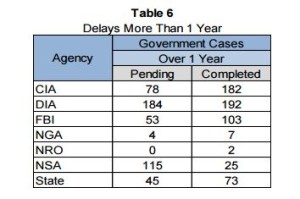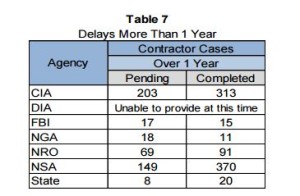
Agencies cut security clearances by another 6 percent in 2015
Agencies are meeting an administration goal to cut the number of federal employees and contractors who need security clearances for their jobs. But the intellig...
Agencies handed out fewer security clearances in 2015 than they did the previous year, as most organizations are growing more strict in determining which federal employees and contractors in fact need access to classified information.
The number of federal employees and contractors eligible for a secret or top-secret clearance dropped by nearly 6 percent over the last year — from about 4.5 million in fiscal 2014 to 4.25 million in 2015, according to a new report from the Office of the Director of National Intelligence.
Agencies as a whole also approved 4 percent fewer security clearances in 2015 over the previous year.
It’s the second consecutive year government pared back its cleared population, after the Obama administration ordered that agencies cut their lists of employees and contractors who need a clearance to access classified data for their jobs.
That governmentwide effort is one reason why the agencies’ clearance-eligible population is down, the report said. But the Defense Department was also successful in collecting more accurate data about its cleared population.
Defense agencies, for example, took a closer look at their cleared employees to verify and update their U.S. citizenship status. DoD regulations require that clearance holders must be U.S. citizens.
“Once the subject’s citizenship value was updated in their personnel center and the [Joint Personnel Adjudication System] as required by DoD regulations, their eligibility was restored if appropriate,” the report said. “During the effort, several thousand records were not restored because eligibility was no longer needed.”
The intelligence community is still struggling to cut down processing times for both initial security clearance applications and periodic reinvestigations, the report said.

IC agencies said “multiple issues,” ranging from administrative complications to foreign influence, caused delays on roughly 45 percent of initial clearance investigations, the report said.
The intelligence community has struggled to process investigations more quickly, in part, because it’s also required to cut the backlog of unprocessed periodic reinvestigations, the report said.
Losing the Electronic Questionnaires for Investigations Processing (e-QIP) system temporarily in July for cybersecurity fixes also contributed to sluggish processing times last year, the ODNI added.
Processing times for security clearances and periodic reinvestigations reached new highs at the end of fiscal 2015 governmentwide. According to a first-quarter update to Performance.gov, initial secret/Tier 3 comb cases took an average of 116 days to process in the beginning of 2016, compared to a 95-day average at the end of 2015. Initial top secret cases took an average of 203 in 2016 so far, compared to a 179-day average by the end of last year.
The administration is in the midst of a major overhaul to the security clearance process, as it begins to stand up a new agency, the National Background Investigations Bureau, with new leadership and a new IT system.
Many lawmakers are skeptical of the plan and have been rather vocal about their concerns. The Senate version of the National Defense Authorization Act also includes a provision that would put DoD in charge of its own security clearance process by the end of 2017.
Copyright © 2024 Federal News Network. All rights reserved. This website is not intended for users located within the European Economic Area.
Nicole Ogrysko is a reporter for Federal News Network focusing on the federal workforce and federal pay and benefits.
Follow @nogryskoWFED
Related Stories





